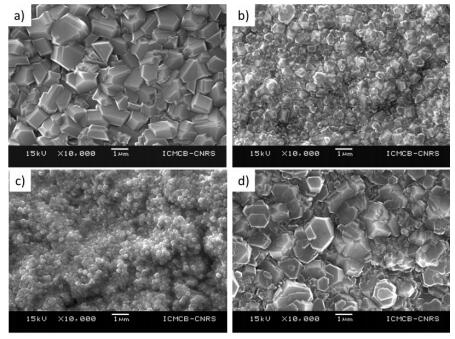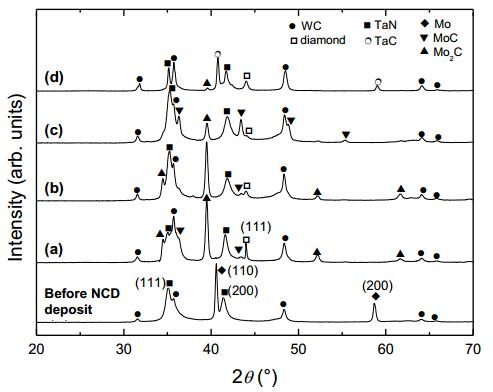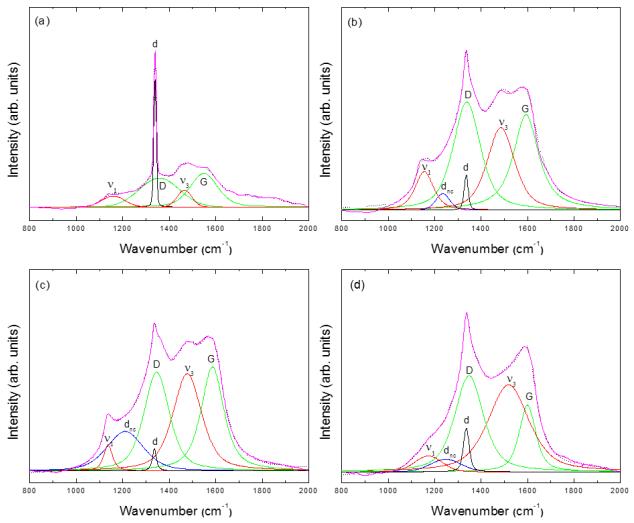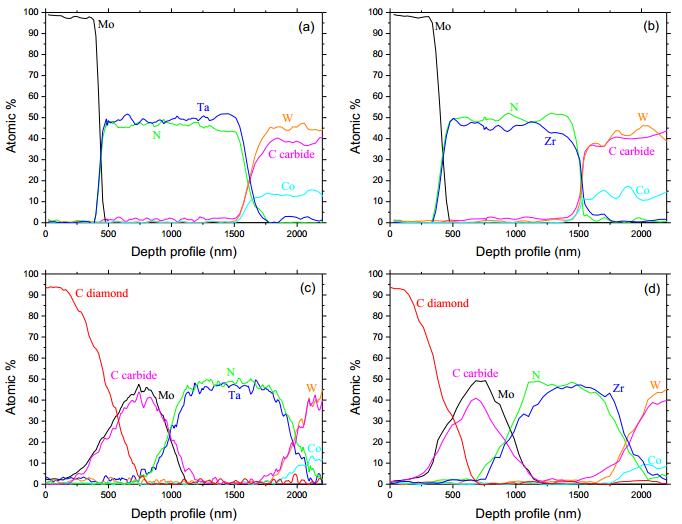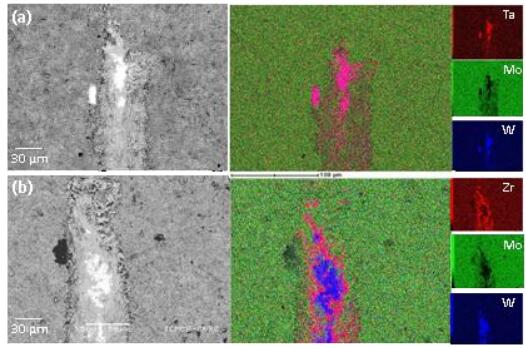Nanocrystalline diamond NCD coatings could improve the performances of cutting tools if the adhesion on cobalt-cemented tungsten carbide WC–Co substrates was optimized and maintained during diamond deposit. In this study, a time modulated polarized growth process during diamond hot filament chemical vapor deposition (HFCVD) method was used. NCD coatings were deposited on cobalt-cemented tungsten carbide (WC–10% Co) substrates previously coated with tantalum or zirconium nitride–molybdenum bilayer as interlayer systems to control carbon and cobalt diffusion. Continuous films consisted of diamond clusters. Their size decreased when the applied bias voltage increased and substrate temperature decreased. Raman analyses confirmed the reduction of crystallite size and formation of nanocrystalline diamond films by time modulated biased substrate HFCVD process. Scratch tests showed that the NCD/interlayer systems/WC–10% Co displayed very good film adhesion interesting for cutting tools applications compared to NCD/WC–10% Co. In addition using an interlayer system could offer additional protection when diamond coating was deteriorated. This technique seems to be promising for industrial applications in the field of machining tools when increasing the thickness of the diamond layer by only extending the time modulated deposition process.
1.
Introduction
Providing world’s population with food is one of the most acute issues these days. Due to climate change and depletion of natural resources food security keeps worsening worldwide [1,2]. Food security of every nation must touch upon different aspects of people’s life while consumption of organic products being the key point. Providing people with basic high-value protein products is one of the priority tasks of both livestock and processing industry. Animal breeding plays an important role in production of such important products as meat and milk. Sensible and balanced feeding of people depends, among other things, on the development and efficiency of animal breeding. In many countries, as well as in Russia, there is a tendency to reduce the livestock population. At the same time, providing people with beef is still one of the most difficult and important problems [3,4]. Increasing the production of high-quality meat should be carried out on the basis of all available reserves which include the increase in the livestock and poultry population, strengthening the fodder base, improving the quality of harvested feed, the use of resource-saving technologies, reducing production and labor costs, feed and funds per product unit [5,6,7,8,9,10,11,12,13,14].
World experience shows that a significant increase in beef production can be achieved by means of intensification of livestock breeding. And first of all it can be done by creating conditions for increasing the level of animal productivity and maximum use of the genetic potential of livestock of both domestic and foreign selection [15]. In various regions of the Russian Federation the main amount of beef is produced by breeding dairy and combined breeds of cattle [16,17].
Young animals in dairy cattle breeding are grown for meat using the technology of “indoors-outdoor feedlot”. First, it is necessary to create comfortable living conditions for calves in order to preserve their health and obtain high productivity. Secondly, older animals are able to adapt rather quickly to environmental factors. Finally, there is commercial importance as fattening young stock can be intensively grown at high rates of labor productivity and profitability. Also expenses for the construction of outdoor feedlots are relatively low and technical solutions are rather simple. However, the analysis of the feedlots activity shows that when rearing young animals for growing and fattening the productivity reduces sharply for a long period of time. This leads to irrational use of feed, reduced growth rate and, as a consequence, the loss of meat products. Therefore, technology of growing and fattening young animals requires further study in order to improve it.
In this regard, the aim of the research was to assess both quantitative and qualitative indicators of meat productivity, depending on the use of different options for rearing and fattening of bull calves, namely indoors and on the outdoor feedlot in the conditions of the Republic of Bashkortostan.
2.
Materials and methods
Ninety calves of 8-month age were selected on the principle of analogues to carry out a research and business experiment in “Akberdinskoye” Limited Liability Company of Iglinsky district of the Republic of Bashkortostan. The animals were divided into 6 groups. The first and the fourth groups were made of calves of black-and-white breed. The calves of Bestuzhev breed were in group two and five, and the 3rd and the 6th groups were made Simmental bull calves. Animals from groups 1, 2, 3 were kept on the outdoor feedlot. Calves from groups 4, 5, 6 were kept indoors. There was yard housing indoors. There were 15 animals having free access to self-filling drinking bowls and feeders in each room.
The experience was conducted according to the requirements of animal breeding, health and sanitation.
Animals were fed according to the diets made taking into account chemical composition of forages and their actual nutritional value according to recommendations [18].
To assess meat productivity, control slaughter of 18-month-old bull calves (live weight being 457.8–511.9 kg) was carried out according to the “Guidelines for the evaluation of meat productivity and meat quality” [19].
In order to study the morphological composition of meat carcass, the right half-carcasses were stripped. Then the content of flesh, bones and tendons in carcasses were determined. The carcass variety assortment was studied according to the classification of sausage production in which beef is divided into three classes: The highest grade is pure muscle tissue with no visible residues of other tissues and entities, in which fat content isn’t more than 6%; the Ist class has no more than 20% of fat; the IInd grade is all the other muscle tissue of the carcass, where there can be small veins, tendons and films.
Physical and chemical parameters of meat were studied using generally accepted methods [20]: Determining moisture content in the samples by drying the sample to a constant weight at a temperature of 150 ± 2 ℃; protein content by the Kjeldahl method followed by photometry of the samples; fat content by extracting the dry weighing batch using the Soxhlet apparatus; ash content by burning in the muffle furnace.
Most of the material obtained during the research was processed with “Statistica 10.0” (“Stat Soft Inc., ” USA) software package. The reliability was determined by the Student’s t-test.
3.
Results
Morphological composition is an important indicator which determines the quality of meat carcass. At the same time, animal keeping and feeding technology influence the morphological composition of carcasses.
The flesh part of the carcass is the most valuable in terms of nutritional value. It consists of muscle and fat tissue, and the greater their content, the higher the nutritional value of meat.
The results of the studies prove that keeping conditions and genetic characteristics influence the morphological composition of the carcasses and the number of their individual parts.
The data of Table 1 indicate that bull calves of Ⅳ-Ⅵ groups have the highest carcass flesh content. They significantly exceeded in weight their herd-mates by 6.3–16.1 kg (P > 0.05–P < 0.01) kept on the outdoor feedlot. It should be noted that among the studied breeds the carcasses of bull calves of Simmental breed had the largest weight of muscle tissue. In this indicator the calves of this breed surpassed their herd-mates of Black-and-white and Bestuzhev breeds by 12.0 kg (P < 0.01) and 6.6 kg (P < 0.05) when keeping animals on the outdoor feedlot and by 21.8 (P < 0.01) and 14.3 kg (P < 0.01) when keeping them indoors. A comparative analysis of the concentration of adipose tissue in carcasses, namely subcutaneous and intermuscular fat, revealed some differences in the nature of fat deposition depending on animal genotype. In particular, bull calves of Simmental breed kept indoors had 0.7–1.3 (P > 0.05–P > 0.05) kg of subcutaneous fat more and 0.3–0.9 kg (P > 0.05–P > 0.05) of intermuscular fat more in comparison with bull calves of Black-and-white and Bestuzhev breeds.
The differences in the overall yield of bone tissue and tendons between the experimental groups were insignificant. At the same time, due to a higher carcass weight of animals of Bestuzhev and Simmental breeds, they surpassed their herd-mates of Black-and-white breed in absolute bone mass by 0.9–1.8%.
An important indicator characterizing the meat quality of animals is fleshing index, which is determined by the flesh to bones ratio. The study results prove that the value of fleshing index of bull calf carcasses of Bestuzhev and Simmental breeds kept indoors is the highest and makes 4.6–4.8.
The yield of flesh per 100 kg of pre-slaughter live weight was relatively high in all experimental groups. However, bull calves genotype as well as technology of their growing and fattening affected the yield of slaughter products. Thus, the yield of flesh per 100 kg of live weight of bull calves of Black-and-white breed kept on the outdoor feedlot was 39.6 kg, the flesh yield of Bestuzhev breed calves weighed 40.0 kg, the same indicator of Simmental breed calves was 40.3 kg; as for animals kept indoors, it was respectively 39.8; 40.6 and 41.2 kg which is higher by 0.7; 1.5 or 2.2 %.
The flesh yield indicator affected the ratio of edible part weight to inedible part weight of the carcass, which was 3.7 for the bull calves of group Ⅰ; 3.6 for group Ⅱ; 3.7 for group Ⅲ; 3.8 for group Ⅳ; 3.9 for group Ⅴ and 4.1 for group Ⅵ.
From the above material it can be concluded that meat quality of carcasses in bull calves of all groups was quite high, but the carcasses of bull calves of Black-and-white breed were more “bony”.
It is well known that different anatomical parts of the carcass differ in a number of morphological parameters which affects their nutritional value, functional and technological properties and taste.
In this respect the most valuable is the hip part. In our study the hip part made 35.5–36.3% of the total mass of the carcass. It is the yield of this cut that largely determines the quality of the carcass as a whole.
The ratios of anatomical parts of bull calves of different breeds were studied. Different technologies were used during the period of growing and fattening of these bull calves. The intergroup differences in the intensity of their weight gain were defined (Table 2).
Thus, bull calves of Simmental breed had the advantage in absolute hip weight of the semi-carcass, regardless of the technology of their growing and fattening. At the same, they surpassed their herd-mates of Bestuzhev and Black-and-white breeds in hip weight by 0.8 kg (1.9%; P > 0.05) and 2.1 kg (5.0%; P > 0.05) kg when kept on outdoor feedlot and by 3.3 kg (7.3%; P > 0.05) and 5.0 kg (11.5%; P < 0.05) when kept indoors. There is some difference in weight of the same part of the semi-carcass of experimental animals, depending on their growing technology. The weight of this part of the semi-carcass of bull calves of Black-and-White breed is greater by 1.5 kg (3.6%), of Bestuzhev breed calves by 1.9 kg (4.4%), and of Simmental breed calves by 4.4 kg (10.0%) in comparison to young animals kept indoors.
Regardless of keeping technology used during their growing and fattening period, Bull calves of Simmental breed surpassed the analogues of Black-and-White and Bestuzhev breeds in neck part weight by 1.1 and 1.4 and 0.1–0.6 kg, in a humeroscapular part weight by 1.5–2.0 and 1.0–1.2 kg; and in a back-rib part weight by 2.1 and 3.3 and 0.7–2.2 kg.
Thus, the bull calves of Simmental breed had superiority over their herd-mates of Black-and-white and Bestuzhev breeds in the absolute weight of all natural anatomical parts of the half-carcass. The ratio of the carcasses cuts of experimental bull calves was determined by their breed and keeping technology.
The established pattern had a positive effect on the increase in the yield of the edible part of the carcass by 1 kg of bones (Table 3).
Data analysis shows that back-rib and humeroscapular parts of the half-carcass had the lowest flesh yield. The maximum flesh yield was revealed in the lumbar part in all studied groups.
At the same time, Simmental bull calves grown on outdoor feedlot had superiority over their herd-mates of the Black-and-White and Bestuzhev breeds in a lumbar part yield by 0.41 kg (6.5%) and 0.21 kg (3.2%), and those grown indoors had superiority by 0.1 kg (1.3%) and 0.35 kg (5.4%), respectively.
We get a fuller picture of meat qualities of an animal thanks to qualitative evaluation of carcass flesh depending on varieties and in accordance with sausage classification. Thus, taking into consideration the fact that variety and technological value of different carcass parts are not identical and depend on morphological structure, the ratio of muscle and fat tissue, fatness, age, breed and sex of an animal, the importance of this issue can not be overestimated. Further use of meat flesh by meat processing enterprises as well as the number and range of meat products are largely determined by its variety assortment.
The data on the variety assortment of the carcass flesh of bull calves of different genotypes are presented in Table 4.
The bull calves of Black-and-White breed kept on the outdoor feedlot were inferior to herd-mates of Bestuzhev and Simmental breeds in the absolute flesh weight of the highest grade by 12.5 and 21.4% (P < 0.05 and P < 0.05) and the first grade by 6, 0 and 11.2% (P > 0.05 and P > 0.05), respectively, and when kept indoors the difference in the flesh content of the highest grade was 12.8 and 27.2% (P < 0.05 and P < 0.01) and the first grade 6.1 and 15.5% (P > 0.05 and P < 0.05).
The quality of the flesh got depends on both the number and ratio of its components and chemical composition. It is known that chemical composition of meat depends on various factors, the main of which are animals breed, sex, age, fatness, as well as their feeding and keeping conditions.
Therefore, it is important to study chemical composition of meat as one of the important indicators characterizing meat products quality.
The data of Table 5 show that the meat obtained from the bull calves kept indoors during the fattening period was characterized by the highest content of dry matter and fat. Their advantage in the content of dry matter in the average sample of minced meat over herd-mates kept on the outdoor feedlot was 2.07–2.21%. These differences are probably due to varying degrees of fat deposits in the body of experimental animals.
In general, beef with good nutritional values was obtained from young animals of all experimental groups.
The ratio of protein and fat in muscle tissue of experimental bull calves in group Ⅰ was 1:0.53, in group Ⅱ it was 1:0.54, in group Ⅲ—1:0.55, in group Ⅳ—1:0.66, in group Ⅴ—1:0.67 and in group Ⅵ it was 1:0.67. Animals of Bestuzhevskoaya and Simmental breeds had the best ratio of protein and fat in muscle tissue.
Energy value of the average minced beef sample got from bull calves of groups Ⅰ, Ⅱ and Ⅲ was inferior to their herd-mates of groups Ⅳ, Ⅴ, and Ⅵ by 84.17 kJ, 82.62 kJ and 83.28 kJ, respectively.
4.
Discussion
During the research it was found that the technological factor and genetic characteristics of animals had a significant impact on production efficiency. Keeping animals indoors helps to realize their inherent genetic potential of meat productivity. Quantitative and qualitative indicators of meat products prove a positive impact of keeping bull calves indoors. The obtained data are consistent with the data of other researchers and make it possible to assert that regardless of the breed the animals kept indoors have better indicators of meat productivity than animals kept on the outdoor feedlot [21,22,23,24].
It should be noted that keeping bull calves indoors during their period of growing and fattening for meat helps to obtain beef with optimal characteristics. The ratio of carcass cuts of experimental bull calves was determined by their breed and keeping technology. The bull calf carcasses of Simmental breed were characterized by maximum meat yield of the highest grades. The bull calf carcasses of Bestuzhev breed occupied an intermediate position meat yield of the highest grades. In the bull calf semi-carcasses of Black-and-White breed there was the maximum meat yield of the second grade. This advantage in the value of the studied indicator over the herd-mates of Simmental and Bestuzhev breeds was 2.3 and 3.9% when keeping experimental animals both on outdoor feedlot and indoors, which is consistent with the [25].
According to the analysis of the average carcass flesh samples, there are certain differences in chemical composition between groups. It can be explained by the fact that the process of nutrient enrichment in the body of bull calves of different genotypes kept under different conditions, took place differently. In general, the chemical composition of the flesh parts of the bull calf carcasses of all groups indicates a high nutritional value. The bull calves grown indoors had some advantage.
5.
Conclusions
Keeping bull calves indoors can improve the post-slaughter indicators of meat productivity and improve beef quality. The study of the morphological composition of carcasses showed that muscle tissue content in the carcasses of animals fed indoors was 179.9–201.7 kg, while those in the carcasses of young animals kept on the outdoor feedlot was 173.6–185.6 kg. There is a greater content of fat tissue in carcasses of bull calves grown and fed indoors. So the total amount of raw fat of bull calves kept indoors was 23.4–26.3 kg, of bull calves kept on the outdoor feedlot it was 20.7–23.7 kg. The bull calves of Simmental breed had superiority over their herd-mates of the Black-and-white and Bestuzhev breeds in the absolute weight of most anatomical parts of the semi-carcass. It is more preferable to fatten young animals of combined breeds for meat producing. Thus, growing and fattening the bull calves of Simmental breed indoors allowed to get the carcasses with the best morphological composition and variety assortment, as well as with the optimal ratio of protein and fat.
Conflict of interest
The authors declare no conflict of interest.









 DownLoad:
DownLoad:



